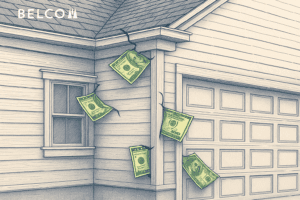Chances are siding corner trim material isn’t at the top of your mind when thinking about building a home. It probably should be, though.
Siding corner trim serves a vital purpose as part of a home’s defense system. In addition, it also makes an architectural statement and influences curb appeal.
The siding, whether it be lap or panel, needs to be terminated or butted up to something so that water can be sealed out.
Moisture can be one of the most costly and detrimental assaults on a building. To learn more about the hazards of water, our article will answer your questions. Moisture-The Root Of Many Problems In Exterior Trim.
There are some companies out there making very small metal clips that act as an outside corner. The purpose is to provide a clean and sleek modern design. But in my opinion, these sacrifice the main purpose of an outside corner-to-corner trim which is to provide a surface to terminate siding and seal out weather with a bead of caulk.
Metal corners being in a category of their own, we won’t compare them here with the other more commonly used outside corner materials.
Siding corner trim does require a little upkeep every 7-8 years. If it cracks or pulls away you can see it right away and easily fix it, whereas metal counterparts rely on much harder to fix sealant systems.
Siding Corner Trim Materials
Corner trim materials are made up of wood or man-made non-wood components. There are several pros and cons to consider.
First we’ll take a look at real wood options.
Real Wood Trim
There are two widely used choices for real wood trim on the market today: cedar or Primed White Wood.
Primed White Wood
PWW comes in the same sizes as cedar but at a fraction of the cost. It is relatively lightweight, very easy to install, and fairly strong.
Not all PWW is created equal. It is important to select a superior product to avoid the dreaded rot.
It has gotten a bad reputation in the past due to the ease that it had succumbed to decay. However, with XT Trim by Belco those days are long gone.
Preservative Treated XT Trim is unique. The raw wood is kiln dried to a perfect moisture level then coated with a preservative by Wolman® AG by Lonza. This preservative sinks into the wood fibers insuring a trim that is protected from water, rot, mildew, and decay.
Lastly, each XT Trim board is painted with a quality white primer and baked in our ovens making it one of the most bulletproof outside corner trim options on the market.
It resists cracking and chipping better than fiber cement while it resists swelling more than OSB.
XT Trim comes with a 20-year warranty against rot, mold, and mildew outshines cedar as the ideal best choice for siding corner trim.
Cedar
Cedar is an excellent choice for outside corner trim. It is lightweight yet sturdy, easy to cut and install, inherently decay resistant, and beautiful.
Western red cedar is available in 1″, 5/4″ and 2″ thick options.
There are a few downsides, however. Cedar typically has no warranty offered.
That’s not so troubling considering how long-lasting cedar is in general.
By far the biggest issue is the cost. Cedar is very expensive and becoming more costly and more difficult to find every year. It can be nearly double in price when compared to the other options.
If cost is not a factor for you, then consider cedar.
Non-Solid Wood Siding Corner Trim
Modern manufacturing innovations have brought some interesting options for corner trim to the market. We’ll take a look at two of the most popular.
Fiber Cement
Fiber cement is becoming more and more popular in the trim and fascia world. It stays straight when exposed to high weather temperatures. Fiber cement is resistant to rot, mold and decay.
It is a fine material for outside corners for those reasons alone. There are significant drawbacks to using it.
Fiber cement is brittle. Think how fragile thinly poured cement is and you get the picture. Therefore it is difficult to install and fragile to handle. Breakage during installation is a common complaint.
Once it is installed, it can be vulnerable to rocks being kicked up into it from lawnmowers and collisions with tools like wheelbarrows, rowdy kids, and other woes of daily living. Cracks and chips are all possible with fiber cement trim, especially as a house settles.
Another thing to think about is the thickness of the material. Corner trim on houses is thicker than the thickest point of the siding so that there is room to apply a constant bead of caulk and have that caulk lower than the face of the corner. This means the fiber cement has to be quite thick to accommodate the siding.
Yet, most fiber cement trim is only 1″ thick, and some are just slightly less than 5/4″. As a result, the only time you can use fiber cement siding corner trim is if you are using fiber cement siding as well.
Most OSB siding as well as real wood siding such as beveled cedar will be too thick for adequate caulk coverage with fiber cement.
OSB Products
Oriented Strand Products are another common material used for house siding corner trim, especially in arid climates.
OSB is strong, fairly heavy, and is manufactured in thicker net dimensions. It is engineered with resins for stability and decay resistance.
One of the best features of OSB is that some manufacturers offer a premade outside corner. This makes one less joint for the installer to caulk and one less joint for the homeowner to maintain down the road.
There are some significant downsides to OSB, however.
Firstly, using a pre-formed outside corner means that there aren’t many options as far as sizing goes. This might not be a problem for spec homes, but for the custom builder or architects, this can raise some concerns.
Secondly, and most importantly, OSB swells at the edges after being wet for long periods of time. This may not rot out the wood chip components, but the boards may swell. This is especially concerning when the bottom corner of trim is only 6″ above ground or if the homeowner has added a depth of mulch or bark to the flower beds.
Once OSB swells with moisture, it does not return to its original shape.
The home’s perceived value can drop because of unsightly swelling on trim board.
Oriented Strand Board based trim may be a good option for outside corner trim in some climates, but why risk potential swelling when there are better options?












